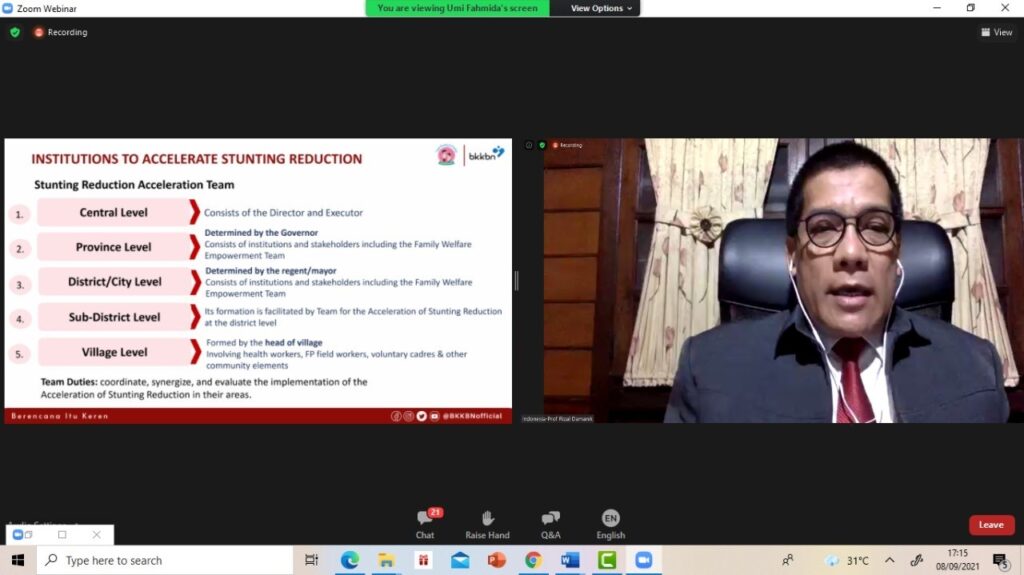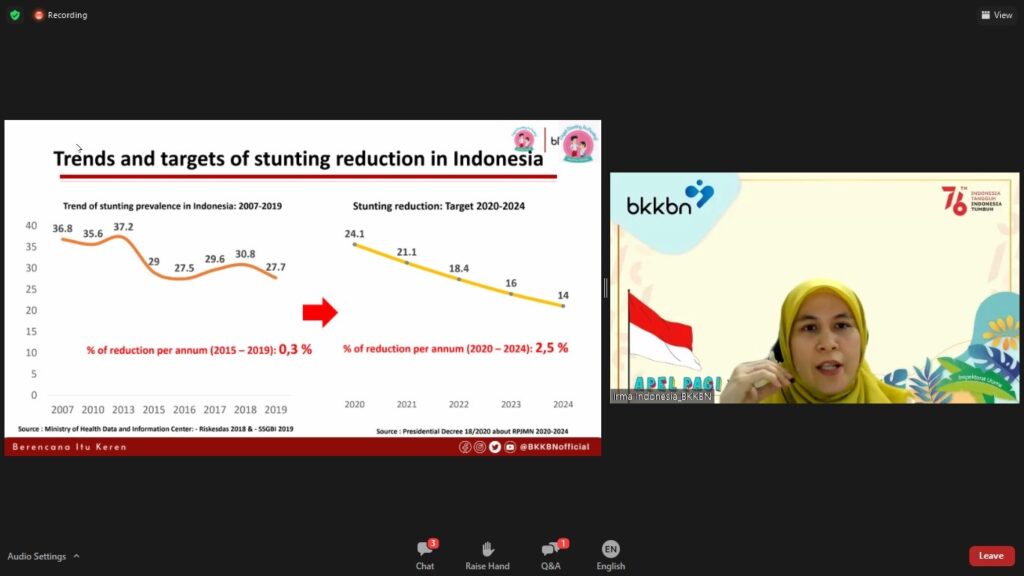Action Against Stunting Awareness Day
Wednesday, 8 September 2021
London – In order to support the action against Stunting, BKKBN attended the Action Against Stunting Day webinar organized by UKRI GCFR (08/09/2021). This forum is implemented based on last year’s data, which 149 million children under the age of five were stunted. Among these children, more than half of them live in Asia, while nearly 40 percent live in Africa. This forum provided opportunity for 3 countries to present the challenges they face so that the UK can maintain its commitment to support developing countries. On this occasion, Indonesia was represented by BKKBN, Prof. drh. Muhammad Rizal Martua Damanik, MRepSc, PhD. accompanied by dr. Irma Ardiana, MAPS.
In his presentation, Prof. Rizal said that one of the top priorities in the field of human development set out by the President of the Republic of Indonesia, Bapak Joko Widodo, is reducing stunting. The problem of stunting must be addressed properly so that future generations of Indonesia can become a superior, competitive, and qualified generation.

Prof. Rizal also explained, “Indonesia has set a target to accelerate stunting reduction to 14% by 2024. Task force on stunting reduction is formed from central to village levels. This team has a role to coordinate, synergize, and evaluate the implementation of the acceleration of stunting reduction in their areas,” he said.

In addition, we have implementing the 5 pillars of strategies to support Stunting Reduction program in Indonesia, namely (1) strengthening the commitment and vision of leaders in ministries/agencies at the central, provincial, district, and village levels; (2) improve communication of behavior change and community empowerment; (3) strengthening the convergence of Specific and Sensitive Nutrition Interventions; (4) increasing food and nutrition security at the individual, family, and community levels; and (5) strengthening and developing systems, data, information, research, and innovation”, explained Prof. Rizal.
Then, dr. Irma Ardiana continued the presentation by explaining how stunting levels and how stunting reduction activities in Indonesia is implemented. She explained, “prevalence of stunting in Indonesia for the last five years 2015 2019 has fluctuated. During this period, the average of reduction was point 3%. In 2019, one out of four children is standing.”, she said.
Indonesia has set a standard reduction target in its national medium-term development plan 2020-2024 to 14% by 2024, this is in line with at least the SDGs target, targets, demand setting and acceleration of extraordinary reductions per year even further in the context of the COVID-19 pandemic. Some provinces fall into a very high category above 30%. Some are high between 20 and below 30%. Soul figures have a unique pattern, where some provinces such as Jakarta managed to catch up with standard baby birth conditions by emphasizing the first 1000 days of life.
Irma explained that in filling the existing gap, it is done to improve the quality of antenatal services, “To fill the gap first to prevent low birth weight and preterm birth by answering antenatal care quality segmenting pregnant mothers at race, providing information on more specific messages on food best recommendation for pregnant mothers and nutrition education for adolescent girls to promote an effective intersectoral collaboration and implementation at program level focusing on the first 1000 days of life, particularly in the fulfillment of complete service package to specific sub population.”, She explained.
In the last minute of the presentation, she added, that “we acknowledge the potential resource of having the involvement of university to assist sub national level for that valid analysis. And also to widen an active case finding of potential standard children and to establish community best reference system at village level.”, said she.
To conclude is to consider nutritional inclusion into universal health coverage, as financing is critical, and also to encourage policy-oriented research that values the determinants of child assurance standing to break the cycle of intergenerational stunting.